Art and Absinthe
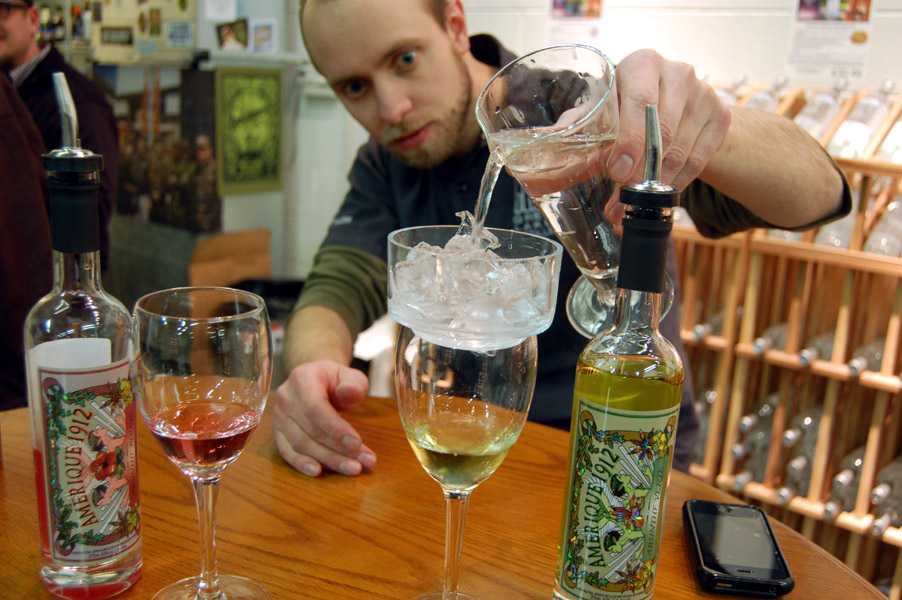 Michael Cothroll is the manager of the Great Lakes Distillery’s sampling bar, the Tasting Room. Behind the bar he expertly pours a jigger or so of the company’s own Amerique 1912 Absinthe Verde into a snifter. It is a bright electric green. In French, it is known as la fée verte – the green fairy.
Michael Cothroll is the manager of the Great Lakes Distillery’s sampling bar, the Tasting Room. Behind the bar he expertly pours a jigger or so of the company’s own Amerique 1912 Absinthe Verde into a snifter. It is a bright electric green. In French, it is known as la fée verte – the green fairy.
He then puts a glass cap (called a brouilleur) filled with ice over the snifter, and pours water in, which drips into the absinthe below. Often a sugar cube is melted into the water, but Cothroll skips this step- he says it covers up the flavor. The drink begins to cloud in the water, known as the louche effect. The color and opacity of the cloud is how absinthe aficionados judge the product, along with its unique anise flavor. As the louche begins to swirl, Cothroll recalls the story of absinthe’s rise to popularity.
THE BEAUTIFUL AGE
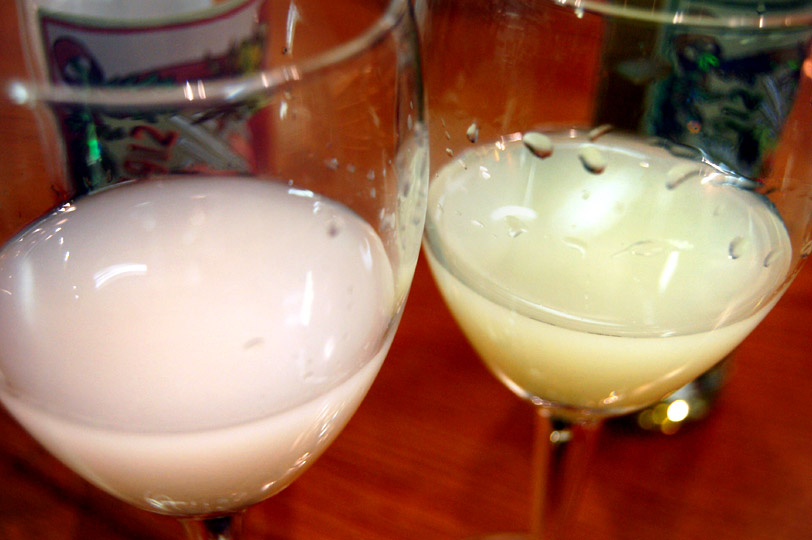 Absinthe had become so popular in France by the late 1800’s, that 5 p.m. was known as l’heure verte (the “green hour,” a direct predecessor of happy hour). After the work day, bars were filled with absinthe drinkers, and all this was thanks to a small yellow pest of the aphid family named phylloxera.
Absinthe had become so popular in France by the late 1800’s, that 5 p.m. was known as l’heure verte (the “green hour,” a direct predecessor of happy hour). After the work day, bars were filled with absinthe drinkers, and all this was thanks to a small yellow pest of the aphid family named phylloxera.
Cothroll explains that the phylloxera epidemic destroyed the vineyards of Europe, particularly those in France, in the mid 1870s. Suddenly wine was a commodity that could only be afforded by the wealthy, resulting in the masses turning to spirits to quench their thirst. Absinthe soon became the drink of choice by the creative bohemian and working classes of Paris in an era known as la Belle Époque (“the Beautiful Age”). However, the absinthe party ended after the wine and brandy industry recovered their vineyards and wanted to regain their status as drink of choice.
“They created a syndicate that launched a smear campaign against absinthe,” Cothroll says.
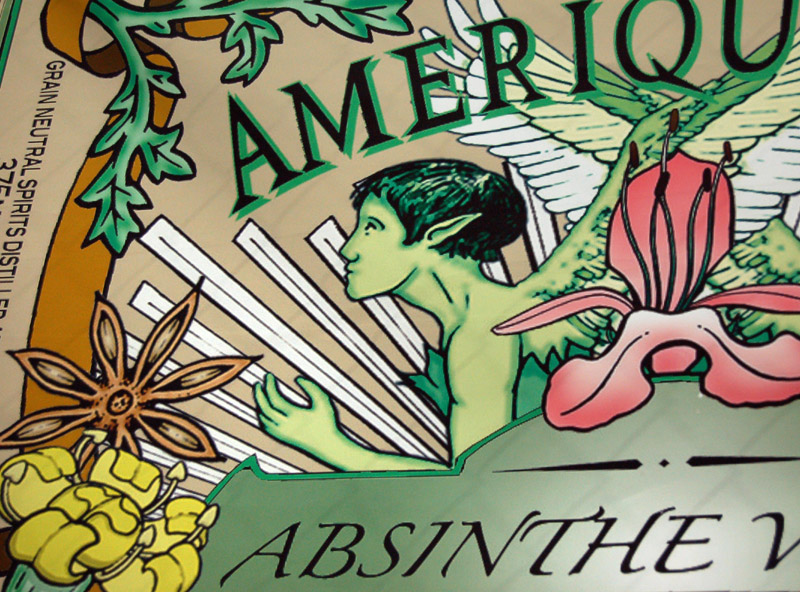 The potent anise-flavored spirit was subsequently framed as having a dangerous impact on society. Misinformation included case studies of absinthe drinkers who, in all likelihood, were actually suffering from the affects of opium or syphilis, both of which were being passed around freely. Faulty experiments, such as injecting rats with wormwood oil, were conducted and the fatal results were blamed on thujone ( a chemical found in wormwood- but also found in common herbs like oregano and sage).
The potent anise-flavored spirit was subsequently framed as having a dangerous impact on society. Misinformation included case studies of absinthe drinkers who, in all likelihood, were actually suffering from the affects of opium or syphilis, both of which were being passed around freely. Faulty experiments, such as injecting rats with wormwood oil, were conducted and the fatal results were blamed on thujone ( a chemical found in wormwood- but also found in common herbs like oregano and sage).
The government bought into the hype and quickly banned absinthe. The restriction spread over much of Europe, and made its way to the United States in 1912, a year is reflected in Great Lakes Distillery’s absinthe line- Amerique 1912– which consists of a traditional green absinthe verde, and rarely attempted red absinthe rouge.
RETURN OF THE FAIRY
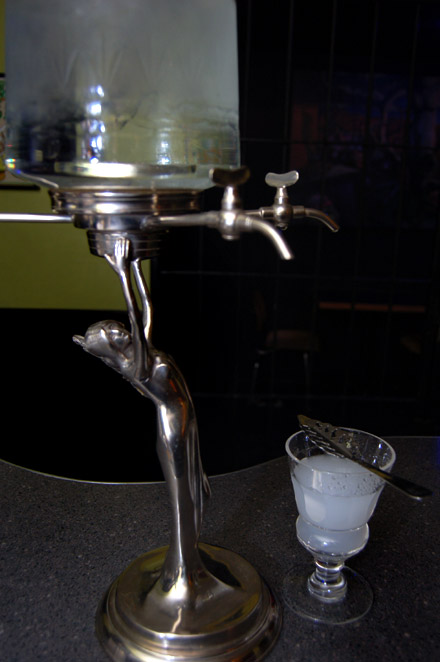 The doorway to make this product was opened in the 2000s. Scientific studies proved that absinthe was not guilty of the claimed harmful effects that had led to its mass prohibition. Countries began legalizing it again, and absinthe was back in business. The United States lifted the ban in 2007, with a few guidelines. The thujone had to be below a certain level, and neither packaging nor advertising could suggest that the drinker would have a psychedelic experience upon imbibing the product.
The doorway to make this product was opened in the 2000s. Scientific studies proved that absinthe was not guilty of the claimed harmful effects that had led to its mass prohibition. Countries began legalizing it again, and absinthe was back in business. The United States lifted the ban in 2007, with a few guidelines. The thujone had to be below a certain level, and neither packaging nor advertising could suggest that the drinker would have a psychedelic experience upon imbibing the product.
Great Lakes Distillery rolled out their first batch of absinthe in September 2009. Cothroll says people often ask him if it is a “real absinthe” and he assures them it is.
“It’s based on the exact recipe from a 150 year old French distiller’s manual,” he says, adding all the ingredients, including the thujone-producing grande wormwood, are present.
After the fairy was freed, it quickly became a hit with restaurants and bars interested in the novelty aspect all over the country. The trend hit Milwaukee; especially with establishments with a European model- Café Hollander, Nessun Dorma, and Café Brucke, among others.
Gary Czaplewski, general manager of Club Anything, has made a more serious commitment to the spirit. In a back room of Club Anything, is a small bar called the Elixir Absinthe Lounge, which opened April 2010 and is devoted entirely to the drink.
“It was new and trendy and I thought it was a market we could corner in a way because no one else is doing it. Other bars have absinthe, but we decided if we’re going to do it, let’s do it all out.” Elixir carries eight kinds of absinthe from around the world, with plans to add more.
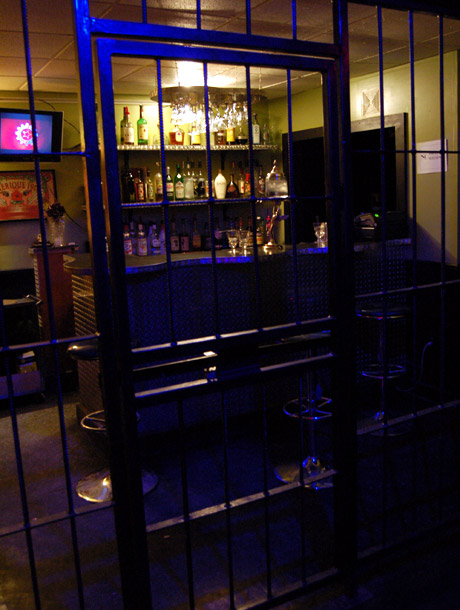 Czaplewski says twenty five percent of the club’s revenue is from absinthe drinks. “We found a natural market for it in our existing clientele,” he explains, noting that Club’s regulars are musicians and artists who bond with the drink’s mysterious nature and rich artistic history. The bar serves absinthe in the traditional method with water drips and sugar cubes, and as an ingredient in a number of creative cocktails.
Czaplewski says twenty five percent of the club’s revenue is from absinthe drinks. “We found a natural market for it in our existing clientele,” he explains, noting that Club’s regulars are musicians and artists who bond with the drink’s mysterious nature and rich artistic history. The bar serves absinthe in the traditional method with water drips and sugar cubes, and as an ingredient in a number of creative cocktails.
To help promote the drink, Czaplewski has joined forces with Cothroll and Great Lakes Distillery to form the Milwaukee Absinthe Society. The group is free to join and hosts absinthe tastings, food pairings, and special events. Czaplewski says the group isn’t just about his Elixir lounge or Amerique 1912, but to help grow a general interest in the culture and history of the drink.
“The Milwaukee Absinthe Society is trying to help make it more accessible. Being a mysterious spirit has been beneficial for us, because it gives the wow factor and brings people in, but I’d like to see the spirit being more widely available everywhere,” according to Czaplewski.
AN ARTISTIC LEGACY
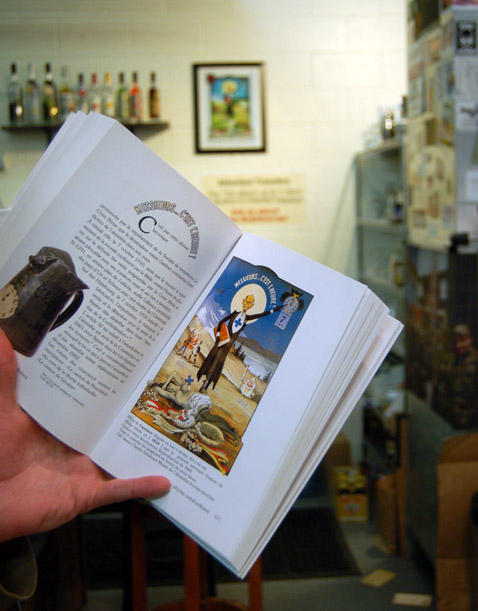 One of the most noteworthy aspects of absinthe is its famous tie in with the creative class. Famous absinthe fans include Vincent van Gogh (“He cut off his ear because he was manic depressive and his overall general alcoholism probably contributed to that, not absinthe in particular,” Cothroll says.) as well as Oscar Wilde, his frequent artistic collaborator Aubrey Beardsley, and Ernest Hemingway, to name a few.
One of the most noteworthy aspects of absinthe is its famous tie in with the creative class. Famous absinthe fans include Vincent van Gogh (“He cut off his ear because he was manic depressive and his overall general alcoholism probably contributed to that, not absinthe in particular,” Cothroll says.) as well as Oscar Wilde, his frequent artistic collaborator Aubrey Beardsley, and Ernest Hemingway, to name a few.
Both Cothroll and Czaplewski say that artists likely found the drink favorable because, for some, it aids their ability to focus. “It doesn’t make you sloppy drunk,” Cothroll says.
The technology to print posters had bloomed in the late 19th century, and the Art Nouveau style was put to use by the artists of Paris to make commercial art for absinthe companies. Artists like Henri de Toulouse-Lautrec, Alphonse Mucha, and Leonetto Cappiello made posters that didn’t just advertise absinthe- they were works of art.
The contest is open now and runs to March 31. The entries will be displayed at the Great Lakes Distillery on gallery night, April 15, and members of the Milwaukee Absinthe Society will vote for the winning design.
The winning artists will receive cash prizes and Great Lakes Distillery products, and carry on a mysterious, artistic legacy. A full list of contest guidelines can be found on the Great Lakes Distillery website.
If you think stories like this are important, become a member of Urban Milwaukee and help support real, independent journalism. Plus you get some cool added benefits.
Art
-
It’s Not Just About the Holidays
 Dec 3rd, 2024 by Annie Raab
Dec 3rd, 2024 by Annie Raab
-
After The Election Is Over
 Nov 6th, 2024 by Annie Raab
Nov 6th, 2024 by Annie Raab
-
The Spirit of Milwaukee
 Aug 30th, 2024 by Annie Raab
Aug 30th, 2024 by Annie Raab





















